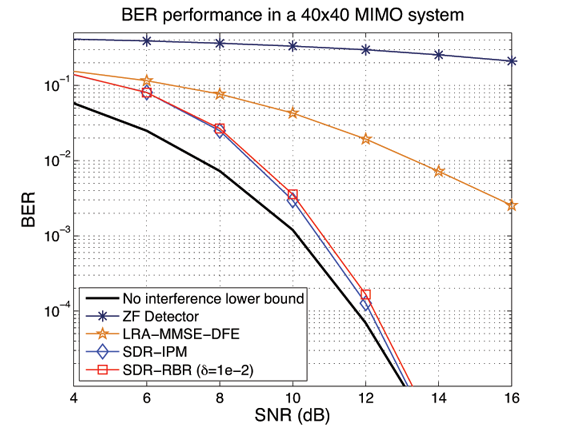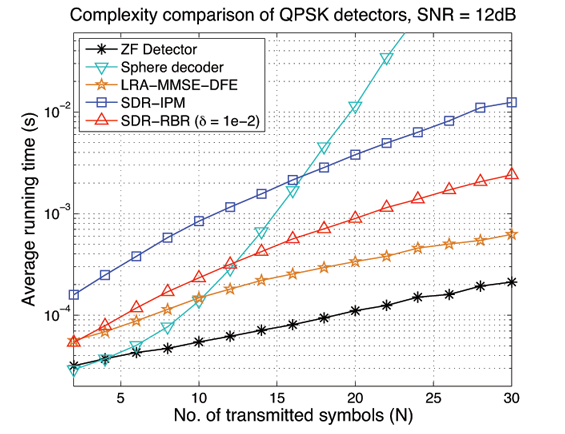Semidefinite relaxation - row by row (SDR-RBR) detector
The archive provided in this page contains ready-to-use binaries and MATLAB functions for the semidefinite relaxation (SDR) detector using the row-by-row (RBR) method, or simply the SDR-RBR detector. The binaries and functions can be freely distributed for academic or personal use. Please contact the authors if you intend to employ the binaries or functions in the archive for commercial purpose.
Source Code
The SDR-RBR BPSK detector is written using C MEX function with minor operation done by MATLAB.
Source codes (last updated on 01-03-2011)
The detector can be invoked as:
[s_hat,iter] = sdr_rbr(y,H,delta,sigma)
where the parameters are
Input parameters
y - received signal vector
 of dimension M by 1.
of dimension M by 1.H - real channel realization matrix
 of dimension M by N.
of dimension M by N.delta - (optional, default =
 ) parameter
) parameter  controlling the solution accuracy,
controlling the solution accuracy,sigma - (optional, default =
 ) parameter
) parameter  controlling the solution accuracy.
controlling the solution accuracy.
Output parameters
s_hat - detected BPSK symbols
 of dimension N by 1.
of dimension N by 1.iter - number of iterations used in the current run.
In the archive we also provide an SDR-RBR program that is written entirely in MATLAB; that MATLAB function is easier to read and may give you some feel, but it runs slower than the C MEX-based code.
SDR-RBR detector
The SDR-RBR detector deals with the ML detection problem with BPSK/QPSK constellation, i.e.,

The SDR-RBR detector is based on the SDR the ML problem

where  is the set of positive semidefinite matrices.
is the set of positive semidefinite matrices.
The RBR method is a new cheap heuristic to solving the SDR problem. The complexity per iteration of RBR is low and is  . Simulation results have shown a ten-times speed up over a tailor-made primal-dual interior point method. Further details regarding the implementation and performance of SDR-RBR detector can be found in
. Simulation results have shown a ten-times speed up over a tailor-made primal-dual interior point method. Further details regarding the implementation and performance of SDR-RBR detector can be found in
H.-T. Wai, W.-K. Ma, A.M.-C. So, “Cheap Semidefinite Relaxation MIMO Detection Using Row-by-Row Block Coordinate Descent,” in Proceedings of the 2011 IEEE Intl. Conf. Acoustic, Speech, and Signal Processing, May 2011. [pdf]
Demonstration
We demonstrate the performance of the SDR-RBR detector in a QPSK scenario.The figures are adopted from the cited paper above.


In the figures above, 'ZF detector’ is abbreivated for the zero-forcing detector, 'SDR-IPM’ for the semidefinite relaxation (SDR) detector implemented using an interior point method (IPM), and 'LRA-MMSE-DFE’ for the lattice-reduction-aided minimum-mean-square-error decision feedback detector.